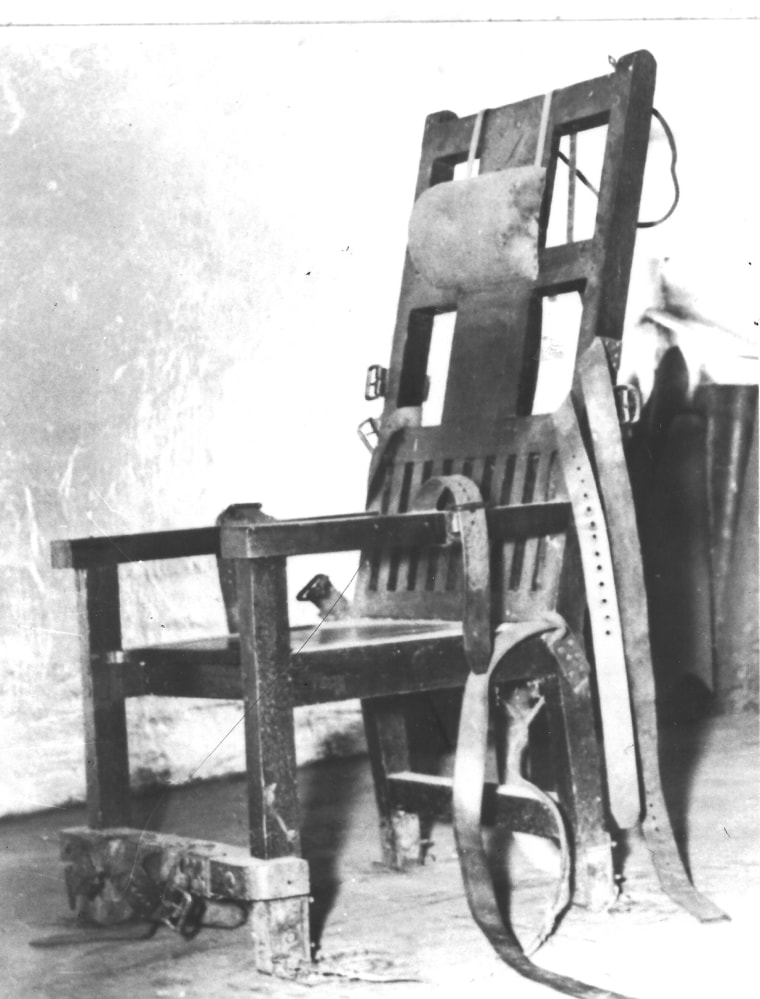The city of McAlester, Oklahoma, is preparing to breathe new life into a feud over an instrument of death — the electric chair that the state used for more than six decades to execute 82 inmates.
The tiny city has long coveted the chair known as “Old Sparky,” which became a relic when the state sidelined it in the 1970s in favor of lethal injections, as a tourist attraction.
But the state Department of Corrections, which spirited it away for its own now-shuttered museum, has refused to return the oak chair first used in 1915 to McAlester, where the state penitentiary and its execution chamber are located.

After an initial attempt in 2014 to regain custody of Old Sparky, the city let the issue lapse. But now officials say they're preparing for a new bid to return the chair to its rightful home — this time, for good.
"It's a very important historical artifact for the city of McAlester and the state of Oklahoma, and it should not be kept locked away in a warehouse," McAlester Mayor John Browne told NBC News. "It should be on display."
The City Council last week discussed a move to authorize officials to draft a letter to the state demanding the return of the chair. A formal decision is likely at next month’s meeting, Browne indicated.
Councilman Buddy Garvin, who for years has pressed the issue, said if the DOC doesn't comply, the city would take legal action.
"It's ours, and we want it," Garvin said. "It's black and white."
Officials with the Department of Corrections did not respond to a request for comment on McAlester’s new threat.
But in 2010, the department's lawyer told the city in a letter that "there is no evidence that the chair was properly transferred to the city pursuant to law," and therefore McAlester didn't have a rightful claim to it, according to local news reports.
The dispute springs from some dealing that occurred in 1980, when McAlester gained control of the chair after the item's retirement as state executioner. The city later loaned it to a private museum in McAlester, the Tannehill Historical Museum, where it remained on display until 1989.
At that time, the DOC planned to open its own museum at the site of the nearby state penitentiary, and asked for the chair back. The city agreed to loan the chair to the prison, and Old Sparky went back to its original home — the penitentiary — where it was displayed inside the visitors center.
Related: Why the Supreme Court Is Acting on the Oklahoma Lethal Injections Case
There it remained, along with other macabre prison memorabilia, until 2011, when the museum run by the Oklahoma Prisons Historical Association was definitively shuttered.
The city at the time said it had an agreement with the association that if the chair wasn't displayed there, it would be returned. But the DOC wanted proof, and the city didn't have the concrete evidence.
Garvin, the McAlester city councilman, told NBC News the city now has the goods to prove it is the rightful owner of the chair, though he couldn’t provide the details.
The Department of Corrections had previously came up with another reason it couldn’t return the chair.
In April 2014, Oklahoma's use of lethal injection became a political issue after an inmate died from a heart attack following an initially botched execution. The state temporarily halted its executions and the use of a three-drug lethal injection cocktail while it determined what went wrong.

At the time, the state told the city that it was holding on to Old Sparky in the event that the chair was its only option for executing inmates.
But that reason no longer exists. The Supreme Court upheld the legality of lethal injections in June 2015.
Given that Oklahoma would no longer need the electric chair as a backup, McAlester officials say the time has come for the state to relinquish the chair.
Asked by NBC News where the chair is being stored as its fate hangs in the balance, a Department of Corrections spokeswoman replied by email that she didn't know and "no one is disclosing the location."
Garvin said he'd like to see the chair return to McAlester by August, when the city plans to observe the 75th anniversary of the murder of a prison warden and a deputy there when four inmates escaped from the state penitentiary. Three of the inmates were killed in a shootout, and the fourth was executed using Old Sparky two years later, in 1943.
August also marks 50 years since the last Oklahoma inmate was strapped into the chair to die. The doomed murderer, James French, is still remembered for his famous last words: "How's this for your headline? 'French Fries.'"
James Tannehill, whose museum hosted the electric chair in the 1980s, said he's in the process of expanding the site and would be willing to keep the chair again for posterity and to preserve history.
He's just worried that if no one acts, Old Sparky will be left to rot — or wind up where it doesn't belong.
"If everyone blows this thing off and doesn’t think anything about it, it will eventually disappear and you won’t find a living soul to tell you where it is," Tannehill said. "It'll be in some politician's den.”
